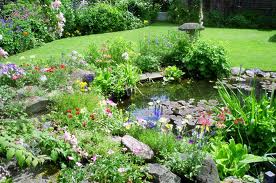





This is a garden for wildlife fanatics: the whole garden is visited by a wide variety of animals, with nothing in it that would not be found in the countryside. The plan is a refuge for wild plants and based on a mature oak tree and a partially fallen tree, which could provide log seats and whose decaying trunk could be used by birds and insects. There could be a small natural stone terrace by the house and an area of grass, which, when cut in late summer would allow daffodils to naturalize and wild flowers to seed. Mown grass paths would allow access through, and around, the meadow to the rest of the garden.
 A large shrubbery could fill one corner, with shrubs selected for their flowers, for bees and butterflies, and their fruit, for birds. A group of trees could fill another corner, which would be underplanted with woodland flowers. The only artificial structure could be a shed, but this could be helped to blend in with its surroundings by having an ivy planted nearby, which over time may take possession of one side. Near the shed could be a patch of weeds and nettles provided specifically as food for hungry caterpillars and a tangle of brambles that could provide flowers, fruits and nesting sites. The bramble and nettles would need to be prevented from running wild over the garden by having any stems cut back that may intrude too far and might be a nuisance to the human users of this area.
A large shrubbery could fill one corner, with shrubs selected for their flowers, for bees and butterflies, and their fruit, for birds. A group of trees could fill another corner, which would be underplanted with woodland flowers. The only artificial structure could be a shed, but this could be helped to blend in with its surroundings by having an ivy planted nearby, which over time may take possession of one side. Near the shed could be a patch of weeds and nettles provided specifically as food for hungry caterpillars and a tangle of brambles that could provide flowers, fruits and nesting sites. The bramble and nettles would need to be prevented from running wild over the garden by having any stems cut back that may intrude too far and might be a nuisance to the human users of this area.
In a low-lying corner could be a small pond for frogs, toads and newts, with an extended bog garden nearby for wetland plants including meadowsweet, purple loosestrife, yellow water iris and hemp agrimony. The pond could have a backdrop of hazel and willow to provide early pollen for bumblebees and sloping sides to allow birds and animals easy access to the water for drinking.
There could be a bird table, but if not, extra food can be put out for birds in the winter, including hanging bunches of millet from tree branches and placing windfall apples on the ground. Fallen leaves from the shrubs and trees would need to be heaped in piles for hedgehog and fieldmice nesting sites, and there could be a small pile of stones near the pond for frogs and toads to hide among; shady spots are very welcome on hot days.
It is perfectly possible and relatively simple to create and to maintain such a garden, but the owners of such delightful wild gardens may well feel that they themselves are the visitors and that the concerns of the resident wildlife are more catered for than their own. A balance is obviously needed to keep all parties happy.
Copyright © www.100flowers.win Botanic Garden All Rights Reserved